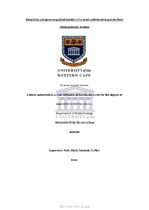| dc.description.abstract | The continued emergence of bacterial resistance to the antibiotics currently employed to treat several diseases has added to the urgency to discover and develop novel antibiotics. It is well established that natural products have been the source of the most effective antibiotics that are currently being used to treat infectious diseases and they remain a major source for drug production. Natural products derived from marine microorganisms have received much attention in recent years due to their applications in human health. One of the biggest bottlenecks in the drug discovery pipeline is the rediscovery of known compounds. Hence, dereplication strategies such as genome sequencing, genome mining and LCMS/MS among others, are essential for unlocking novel chemistry as it directs compound discovery away from previously described compounds. In this study, the genome of a marine microorganism, Thalassomonas viridans XOM25T was mined and its antimicrobial activity was assessed against a range of microorganisms. Genome sequencing data revealed that T. viridans is a novel bacterium with an average nucleotide identity of 81% to its closest relative T. actiniarum. Furthermore, genome mining data revealed that 20% of the genome was committed to secondary metabolisms and that the pathways were highly novel at a sequence level. To our knowledge, this species has not previously been exploited for its antimicrobial activity. Hence, the aim of this study was to screen for bioactivity and identify the biosynthetic gene/s responsible for the observed bioactivity in T. viridans using a bioassay-and-genome- guided isolation approach to assess the bioactive agent. The bioassay-guided fractionation approach coupled to LCMS/MS led to the identification of a novel antimicrobial protein, TVP1. Bioinformatic analyses showed that TVP1 is a novel antimicrobial protein that is found in the tail region of a prophage in the T. viridans genome. Phage-derived proteins have previously been shown to induce larval settlement in some marine invertebrates. Since the mechanism of action of TVP1 remains unknown, it remains a speculation whether it may offer a similar function. More research is required to determine the biotechnological application and the role of TVP1 in its host and natural environment. | en_US |

